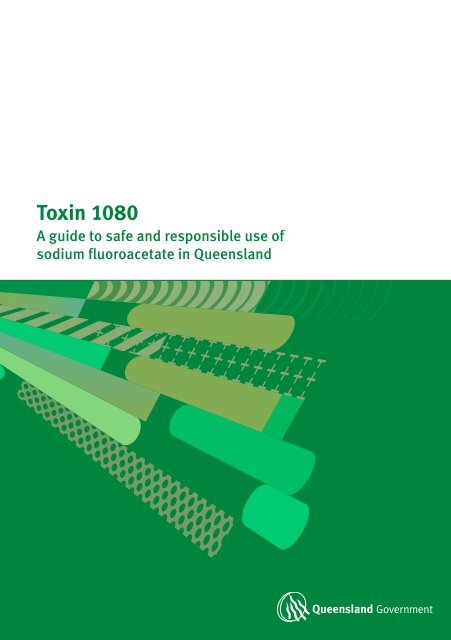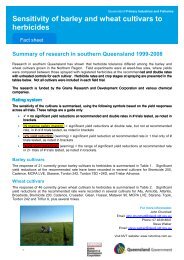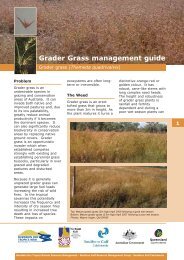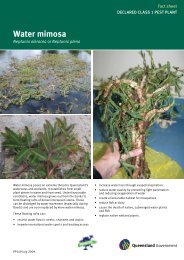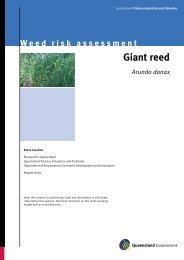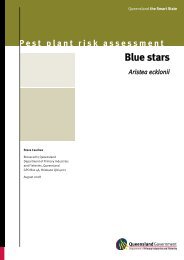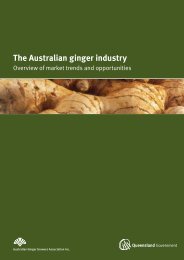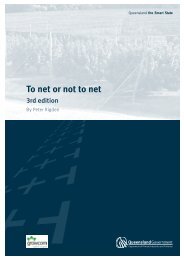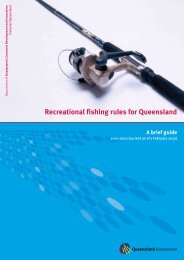Toxin 1080 - Department of Primary Industries
Toxin 1080 - Department of Primary Industries
Toxin 1080 - Department of Primary Industries
Create successful ePaper yourself
Turn your PDF publications into a flip-book with our unique Google optimized e-Paper software.
<strong>Toxin</strong> <strong>1080</strong><br />
A guide to safe and responsible use <strong>of</strong><br />
sodium fluoroacetate in Queensland
PR09–4046<br />
On 26 March 2009, the <strong>Department</strong> <strong>of</strong> <strong>Primary</strong> <strong>Industries</strong> and Fisheries was amalgamated<br />
with other government departments to form the <strong>Department</strong> <strong>of</strong> Employment, Economic<br />
Development and Innovation.<br />
© The State <strong>of</strong> Queensland, <strong>Department</strong> <strong>of</strong> Employment, Economic Development and<br />
Innovation, 2009.<br />
Except as permitted by the Copyright Act 1968, no part <strong>of</strong> the work may in any form or by any<br />
electronic, mechanical, photocopying, recording, or any other means be reproduced, stored<br />
in a retrieval system or be broadcast or transmitted without the prior written permission <strong>of</strong><br />
the <strong>Department</strong> <strong>of</strong> Employment, Economic Development and Innovation. The information<br />
contained herein is subject to change without notice. The copyright owner shall not be liable<br />
for technical or other errors or omissions contained herein. The reader/user accepts all risks<br />
and responsibility for losses, damages, costs and other consequences resulting directly or<br />
indirectly from using this information.<br />
Enquiries about reproduction, including downloading or printing the web version, should be<br />
directed to ipcu@dpi.qld.gov.au or telephone +61 7 3225 1398.
Contents<br />
Introduction 1<br />
Step 1: Apply to use <strong>1080</strong> baits 3<br />
Step 2: Ensure personal safety 4<br />
Step 3: Ensure community safety 7<br />
Step 4: Protect working dogs and pets 12<br />
Step 5: Protect wildlife and the environment 13<br />
Step 6: Use efficient application and distribution methods 14<br />
Appendix 1: Checklist for owners 22<br />
Appendix 2: Property/land description record 24<br />
Appendix 3: Notification <strong>of</strong> proposed sodium fluoroacetate<br />
(<strong>1080</strong>) baiting program 25<br />
Appendix 4: Agreement to proposed declared pest animal baiting program 27<br />
Appendix 5: Record <strong>of</strong> notifications and agreements 28<br />
Appendix 6: Authority to sign 30<br />
Glossary 32
Introduction<br />
Sodium fluoroacetate (<strong>1080</strong>) is a<br />
pesticide used to control declared pest<br />
animals—dingoes, wild dogs, foxes,<br />
rabbits, feral pigs and feral cats.<br />
<strong>Toxin</strong> <strong>1080</strong> is the most efficient,<br />
humane and species-specific pesticide<br />
currently available for declared pest<br />
animal control in Australia. It is a<br />
white, odourless, powdery substance<br />
similar in appearance to flour. It is<br />
virtually tasteless and is colourless when<br />
dissolved in water (all stocks <strong>of</strong> <strong>1080</strong><br />
powder and solution are coloured with<br />
a blue-black dye as a safety marker).<br />
<strong>Toxin</strong> <strong>1080</strong> is water soluble and it does<br />
not cause a build up <strong>of</strong> toxic residues in<br />
soil, water or plants—it is broken down<br />
naturally by water and soil bacteria. The<br />
acid form <strong>of</strong> fluoroacetate is known to<br />
exist in 30 species <strong>of</strong> native Australian<br />
plants, including Acacia georginae<br />
(Georgina gidgee), Gastrolobium<br />
spp. (e.g. heart leaf poison bush) and<br />
Oxylobium spp. (e.g. box poison bush).<br />
Each <strong>of</strong> these species has been known<br />
to poison domestic livestock. Generally,<br />
native animal species are less susceptible<br />
to <strong>1080</strong> than introduced species.<br />
It should be noted that <strong>1080</strong> is a<br />
highly toxic compound, which is<br />
subject to strict regulatory control<br />
administered by Queensland Health.<br />
The penalties for the misuse <strong>of</strong> <strong>1080</strong><br />
are prescribed by the Health (Drugs<br />
and Poisons) Regulation 1996.<br />
Warning: There is no known<br />
antidote for <strong>1080</strong> poisoning.<br />
Misuse <strong>of</strong> <strong>1080</strong> may also constitute<br />
an <strong>of</strong>fence under the Animal Care and<br />
Protection Act 2001 (administered by the<br />
<strong>Department</strong> <strong>of</strong> Employment, Economic<br />
Development and Innovation (DEEDI)<br />
and the RSPCA) and/or the Nature<br />
Conservation Act 1992 (administered<br />
by the <strong>Department</strong> <strong>of</strong> Environment<br />
and Resource Management (DERM)).<br />
<strong>Toxin</strong> <strong>1080</strong> is a restricted chemical<br />
product. Only approved DEEDI and<br />
local government <strong>of</strong>ficers who have<br />
undertaken practical and written<br />
examinations, and received approval<br />
from Queensland Health, are permitted<br />
to prepare and supply <strong>1080</strong> baits.<br />
These approved <strong>of</strong>ficers are known as<br />
‘Authorised Persons’. <strong>Toxin</strong> <strong>1080</strong> can<br />
only be supplied as prepared baits for<br />
the purpose <strong>of</strong> controlling declared<br />
pest animals—<strong>1080</strong> concentrate cannot<br />
be supplied directly to the public.<br />
Queensland <strong>Primary</strong> <strong>Industries</strong> and Fisheries 1
This booklet provides information on how to implement the six<br />
steps to safe and responsible use <strong>of</strong> <strong>1080</strong> in Queensland:<br />
1. Apply to use <strong>1080</strong> baits.<br />
2. Ensure personal safety.<br />
3. Ensure community safety.<br />
4. Protect working dogs and pets.<br />
5. Protect wildlife and the environment.<br />
6. Use efficient application and distribution methods.<br />
All people using <strong>1080</strong> in baiting programs for declared pest animals in<br />
Queensland must abide by the instructions in this booklet and any directions<br />
or conditions placed upon them by the relevant Authorised Persons. <strong>Toxin</strong><br />
<strong>1080</strong> is not to be used for any purpose, or in any manner, contrary to the<br />
information in this booklet, unless authorised by the appropriate legislation.<br />
2 <strong>Toxin</strong> <strong>1080</strong>: A guide to safe and responsible use <strong>of</strong> sodium fluoroacetate in Queensland
Step 1: Apply to use <strong>1080</strong> baits<br />
<strong>Toxin</strong> <strong>1080</strong> cannot be sold directly<br />
to the public. Authorised persons can<br />
only supply baits prepared with <strong>1080</strong><br />
(not to exceed 0.03% fluoroacetic<br />
acid) to landowners for the control <strong>of</strong><br />
declared pest animals. Owners may also<br />
purchase commercially manufactured<br />
baits from Authorised Persons.<br />
Owners that want to participate in<br />
a baiting program must inform the<br />
local Authorised Person (your local<br />
council will be able to provide this<br />
information). The Authorised Person<br />
will require information about your<br />
property size and where you intend to<br />
place baits. If you are in a closely settled<br />
area, restrictions may apply and your<br />
local Authorised Person will inform<br />
you <strong>of</strong> any further requirements (see<br />
Step 3: Ensure community safety).<br />
Owners must complete an ‘Agreement<br />
for the provision <strong>of</strong> baits for the control<br />
<strong>of</strong> declared pest animals’ (provided<br />
by the Authorised Person when the<br />
owner receives the baits). By signing<br />
the agreement, owners agree to comply<br />
with the requirements for use <strong>of</strong> the<br />
baits and indemnify the state or local<br />
government against any claims or losses.<br />
The agreement must be signed before the<br />
Authorised Person provides the owner/<br />
approved agent with prepared baits.<br />
Failure to comply with any conditions or<br />
additional conditions in the agreement<br />
may result in the withdrawal <strong>of</strong><br />
future bait preparation services.<br />
Authority to sign<br />
If an owner elects an agent to<br />
collect baits on their behalf, an<br />
‘Authority to sign’ form (Appendix 6)<br />
should be completed.<br />
Working through the ‘Checklist<br />
for owner’s’ (Appendix 1) will help<br />
you prepare for a baiting program<br />
and ensure your application meets<br />
the safe use requirements.<br />
Queensland <strong>Primary</strong> <strong>Industries</strong> and Fisheries 3
Step 2: Ensure personal safety<br />
Safety precautions<br />
<strong>Toxin</strong> <strong>1080</strong> concentrate is very<br />
dangerous and poisonous if<br />
swallowed. You must avoid<br />
contact with eyes and skin.<br />
Warning: There is no known<br />
antidote for <strong>1080</strong> poisoning.<br />
When handling <strong>1080</strong> baits, the following<br />
safety precautions should be followed:<br />
• Always wear appropriate personal<br />
protective equipment (e.g. overalls,<br />
elbow-length PVC gloves and rubber<br />
boots).<br />
• Keep children and animals away from<br />
baits.<br />
• Don’t place baits near food or drink<br />
items.<br />
• Lay the baits as soon as possible—don’t<br />
do other jobs beforehand.<br />
• Once the baits are laid, wash<br />
containers thoroughly with soap and<br />
water, discard the solution and wash<br />
it into the soil. Any plastic containers<br />
or bags should be buried in a deep pit<br />
(ensure the pit is deep enough so other<br />
animals, particularly domestic dogs,<br />
are unlikely to retrieve the containers).<br />
• Check that the solution has not leaked<br />
onto the back <strong>of</strong> the vehicle. Wash<br />
the vehicle thoroughly if a leak has<br />
occurred.<br />
• Dispose <strong>of</strong> all unused baits by burning<br />
or burying in a deep pit (ensure the<br />
pit is deep enough so other animals,<br />
particularly domestic dogs, are unlikely<br />
to retrieve baits).<br />
• Before eating, drinking or smoking,<br />
wash arms and face thoroughly with<br />
soap and water.<br />
• After laying the baits, wash personal<br />
protective equipment and clothing<br />
thoroughly.<br />
• At the completion <strong>of</strong> the job, bathe<br />
thoroughly and change into clean<br />
clothing.<br />
Storage<br />
Only authorised personnel should<br />
have access to baits (authorised<br />
personnel include people who have<br />
signed an agreement for provision<br />
<strong>of</strong> baits, or employees operating<br />
under their instruction). Baits must<br />
be transported and stored in such<br />
a way that unauthorised personnel<br />
cannot gain access to them.<br />
Do not allow baits to be accessible to<br />
children, livestock or domestic pets.<br />
Baits must be kept in the container<br />
bearing the label, as supplied<br />
by the manufacturer.<br />
4 <strong>Toxin</strong> <strong>1080</strong>: A guide to safe and responsible use <strong>of</strong> sodium fluoroacetate in Queensland
Do not allow baits to contaminate<br />
foodstuff or feed for human or nontarget<br />
animal consumption.<br />
Containers that have held product<br />
are not to be used for any other<br />
purpose and must be disposed <strong>of</strong> by<br />
burying in a deep pit (see ‘Safety<br />
precautions’ on previous page).<br />
Users must not store baits after a<br />
baiting campaign is complete—all<br />
unused baits must be burned or<br />
buried in a deep pit (see ‘Safety<br />
precautions’ on previous page).<br />
Queensland <strong>Primary</strong> <strong>Industries</strong> and Fisheries 5
First aid<br />
If poisoning occurs, contact the Queensland Poisons Information Centre<br />
immediately on 13 11 26 (poisoning advice is available Australia-wide, 24 hours<br />
a day, 7 days a week) or seek immediate medical attention.<br />
Remove the affected person from the contaminated area (take precautions to<br />
avoid exposure to the toxin).<br />
If the patient has collapsed or is not breathing, ring 000 for an ambulance<br />
immediately.<br />
If the patient has collapsed, but is still breathing, put them in the recovery position.<br />
If the patient is not breathing or their heart has stopped, apply CPR—ensure no<br />
evidence <strong>of</strong> the poison or vomit is present around the mouth (clean the area with<br />
a damp cloth). Assess the situation carefully to avoid ingesting the poison.<br />
If skin contact occurs, remove contaminated clothing, flood skin with running<br />
water and then wash with soap and water.<br />
If the toxin comes in contact with eyes, hold eyes open and irrigate the eye with a<br />
continuous stream <strong>of</strong> water for at least 15 minutes.<br />
6 <strong>Toxin</strong> <strong>1080</strong>: A guide to safe and responsible use <strong>of</strong> sodium fluoroacetate in Queensland
Step 3: Ensure community safety<br />
Distance requirements and<br />
exclusion zones<br />
Owners must follow eight rules<br />
regarding the placement <strong>of</strong> <strong>1080</strong> baits:<br />
1. Baits are to be laid on the land<br />
described in the agreement for<br />
provision <strong>of</strong> baits only.<br />
2. No baits are to be laid on any stock<br />
route or reserve for travelling stock<br />
without local government approval.<br />
3. No baits are to be laid within 5 m <strong>of</strong> a<br />
fenced boundary.<br />
4. No baits are to be laid within 50 m <strong>of</strong><br />
the centre line <strong>of</strong> a declared road.<br />
5. No baits are to be laid within 20 m <strong>of</strong><br />
permanent or flowing water bodies.<br />
6. Owners may only lay baits within<br />
1 km <strong>of</strong> any habitation (habitation<br />
includes schools, dwellings and public<br />
facilities, but does not include the<br />
dwelling <strong>of</strong> the person laying the baits)<br />
if they first seek written agreement<br />
from all habitation occupiers within<br />
1 km <strong>of</strong> the bait site. At least 80 per<br />
cent agreement must be gained before<br />
baiting can proceed. The Authorised<br />
Person may increase this to 100 per<br />
cent written agreement if required as a<br />
further risk mitigation measure.<br />
7. Owners may only lay baits within 2 km<br />
<strong>of</strong> any habitation (habitation includes<br />
schools, dwellings and public facilities,<br />
but does not include the dwelling <strong>of</strong><br />
the person laying the baits) after they<br />
provide written notification to all<br />
habitation occupiers within 2 km <strong>of</strong> the<br />
bait site.<br />
8. No baits are to be laid within 5 km<br />
<strong>of</strong> a town without land protection<br />
<strong>of</strong>ficer approval.<br />
Rules for closely settled areas<br />
A closely settled area is defined as<br />
‘an area where there are 20 or more<br />
inhabited dwellings or public facilities<br />
that are occupied within a 2 km radius’.<br />
To facilitate baiting in closely settled<br />
areas, owners must seek permission<br />
from the local Authorised Person.<br />
Owners wishing to bait must<br />
demonstrate to the Authorised Person<br />
that they have a genuine need for<br />
baiting and have complied with the<br />
neighbour notification guidelines.<br />
Queensland <strong>Primary</strong> <strong>Industries</strong> and Fisheries 7
Owners wishing to bait in closely settled<br />
areas are required to provide maps that<br />
identify (either on the map or on an<br />
accompanying schedule) the proposed<br />
location <strong>of</strong> baits and the distance <strong>of</strong><br />
these locations from towns, public<br />
facilities, boundary fences and roads.<br />
The Authorised Person will<br />
consider appropriate risk mitigation<br />
measures that will be prescribed<br />
as additional conditions in the<br />
agreement for provision <strong>of</strong> baits.<br />
In closely settled areas, uneaten<br />
baits must be collected within<br />
seven days unless the Authorised<br />
Person deems it impractical.<br />
Risk mitigation<br />
To reduce the risk <strong>of</strong> accidental<br />
poisoning <strong>of</strong> non-target animals,<br />
including domestic animals, the local<br />
Authorised Person must consider<br />
prescribing additional conditions in<br />
the agreement for provision <strong>of</strong> baits.<br />
Authorised persons and owners should<br />
consider the following risk mitigation<br />
measures as additional conditions<br />
when baiting in closely settled areas<br />
and other potentially risky situations.<br />
Planning measures to consider include:<br />
• landowner education<br />
• a formal application process (i.e.<br />
applying in writing)<br />
• site inspection prior to baiting<br />
• written notification to all neighbours<br />
• written or verbal agreement by<br />
neighbours<br />
• agreement/ownership and planning by<br />
the local community<br />
• coordination <strong>of</strong> baiting by key owners<br />
• participation by adjoining properties<br />
• GPS/mapping <strong>of</strong> bait distribution<br />
• local community awareness (e.g.<br />
media, letter drops)<br />
• extra signs at intervals along the<br />
boundary or within the baited area<br />
• splitting indemnity (e.g. between land<br />
owner and pilot).<br />
Application and distribution<br />
measures to consider include:<br />
• using alternative toxins (e.g.<br />
strychnine)<br />
• decreasing the dose rate<br />
• bait type variations (e.g. fruit)<br />
• increasing the bait size<br />
• restricting bait numbers<br />
• increasing awareness <strong>of</strong> non-target<br />
animals<br />
• targeting hot spots<br />
• pre-feeding (un-poisoned baits)<br />
• bait stations<br />
• bait timing (e.g. seasonal, day, night)<br />
8 <strong>Toxin</strong> <strong>1080</strong>: A guide to safe and responsible use <strong>of</strong> sodium fluoroacetate in Queensland
• bait location in relation to pest<br />
behaviour<br />
• aerial distribution<br />
• using alternative techniques (e.g.<br />
trapping)<br />
• baits laid by land protection <strong>of</strong>ficer<br />
• burying baits<br />
• using tied baits<br />
• monitoring (bait take, non-target<br />
impact).<br />
Neighbour notification<br />
Neighbours must be notified to allow<br />
them to take appropriate action.<br />
Owners must give at least 72 hours<br />
notification to all neighbours whose<br />
property boundary falls within<br />
2 km <strong>of</strong> the proposed bait site and<br />
any property having frontage to the<br />
holding where baits are to be laid.<br />
The notification must advise that<br />
steps (e.g. restraint, muzzling)<br />
need to be taken to ensure that<br />
domestic dogs do not gain access to<br />
<strong>1080</strong> baits or poisoned animals.<br />
The notification must specify the dates<br />
between which baiting will occur.<br />
This notification must be in<br />
writing in closely settled areas.<br />
Baiting must commence within 10 days<br />
<strong>of</strong> notification, otherwise another<br />
72 hours notification is required.<br />
A record <strong>of</strong> the notifications must<br />
be kept (see Appendix 5 for a record<br />
sheet and suggested wording for<br />
written notification to neighbours).<br />
Signage<br />
Signage is compulsory for all land on<br />
which baiting occurs. Signs will be<br />
provided by the local Authorised Person.<br />
Owners must ensure that signs are put<br />
up immediately before <strong>1080</strong> poisoning<br />
operations commence on the property.<br />
Signs must be placed at all entrances<br />
to the property and at the extremities<br />
<strong>of</strong> the property boundaries fronting<br />
a public thoroughfare. This must be<br />
done even if the adjoining property<br />
is carrying out <strong>1080</strong> baiting.<br />
Signage must include the following<br />
information:<br />
• the date the baits were laid<br />
• a contact telephone number<br />
• the toxin name<br />
• the target animal(s)<br />
Queensland <strong>Primary</strong> <strong>Industries</strong> and Fisheries 9
• a warning that domestic animals and<br />
pets can be affected.<br />
Signs must be left in place for one<br />
month after the baits have been laid.<br />
Misuse <strong>of</strong> baits and withdrawal<br />
<strong>of</strong> bait preparation services<br />
Misuse <strong>of</strong> <strong>1080</strong> in Queensland is<br />
governed by the Health (Drugs<br />
and Poisons) Regulation 1996<br />
(administered by Queensland Health)<br />
The maximum penalty for not<br />
complying with conditions in the<br />
agreement for provision <strong>of</strong> baits<br />
is 80 penalty units ($8 000).<br />
Misuse <strong>of</strong> <strong>1080</strong> in Queensland may<br />
also constitute an <strong>of</strong>fence under the<br />
Animal Care and Protection Act 2001<br />
(administered by DEEDI and the RSPCA)<br />
and/or the Nature Conservation Act<br />
1992 (administered by DERM).<br />
Reports <strong>of</strong> misuse or non-compliance<br />
with the guidelines should be reported<br />
to the local Authorised Person in<br />
the first instance and/or another<br />
appropriately trained <strong>of</strong>ficer from<br />
DEEDI or local government.<br />
Where a complainant raises a<br />
question about the appropriateness<br />
<strong>of</strong> actions taken by a specified<br />
Authorised Person in supplying baits<br />
to owners or prescribing conditions<br />
on the laying <strong>of</strong> baits, or the failure<br />
<strong>of</strong> a specified Authorised Person<br />
to take appropriate actions or to<br />
provide appropriate supervision, the<br />
specified Authorised Person is not<br />
to be involved in any way in the<br />
investigation <strong>of</strong> the complaint and<br />
must refer the complainant to another<br />
Authorised Person immediately.<br />
When an Authorised Person receives<br />
a complaint (written or verbal) or<br />
becomes aware <strong>of</strong> a possible breach,<br />
the Authorised Person (if eligible, i.e.<br />
their actions are not being investigated)<br />
provides the complainant with access<br />
to the complaints process by:<br />
1. requesting that the complainant writes<br />
to the local land protection <strong>of</strong>ficer<br />
outlining all details <strong>of</strong> the incident.<br />
2. advising the complainants that if they<br />
wish to pursue the matter <strong>of</strong> suspected<br />
poisoned non-target animals to the<br />
fullest extent, the animals must be<br />
autopsied to confirm the presence <strong>of</strong><br />
the toxin<br />
3. referring the matter to the local land<br />
protection <strong>of</strong>ficer.<br />
10 <strong>Toxin</strong> <strong>1080</strong>: A guide to safe and responsible use <strong>of</strong> sodium fluoroacetate in Queensland
The land protection <strong>of</strong>ficer (if eligible)<br />
will do a preliminary investigation.<br />
They will contact the relevant parties<br />
involved in the case to establish<br />
the facts. Subsequently, the land<br />
protection <strong>of</strong>ficer refers the outcomes<br />
<strong>of</strong> the preliminary investigation to<br />
the relevant authority if required.<br />
Consequences for misuse can include:<br />
• the owner being given a warning<br />
notice that services will be<br />
withdrawn if all conditions<br />
governing appropriate use <strong>of</strong> baits<br />
are not complied with in future<br />
• conditions placed on the owner in<br />
the next baiting cycle, including<br />
that the owner place and collect<br />
baits only under the supervision<br />
<strong>of</strong> an Authorised Person<br />
• withdrawal <strong>of</strong> all baiting services<br />
• possible investigation and prosecution<br />
under the Health (Drugs and Poisons)<br />
Regulation 1996.<br />
• possible investigation under the<br />
Animal Care and Protection Act 2001<br />
• possible investigation under the Nature<br />
Conservation Act 1992.<br />
Queensland <strong>Primary</strong> <strong>Industries</strong> and Fisheries 11
Step 4: Protect working dogs and pets<br />
There is considerable variation in<br />
susceptibility to <strong>1080</strong> between animal<br />
species. In general, cold-blooded animals<br />
such as reptiles and fish are the most<br />
resistant <strong>of</strong> all animals to <strong>1080</strong>, while<br />
birds show considerably more resistance<br />
than mammals. Dogs and cats are the<br />
animals most susceptible to <strong>1080</strong>.<br />
Dogs can receive a lethal dose<br />
if they ingest saliva or vomit <strong>of</strong><br />
other poisoned dogs or animals.<br />
Dogs will readily lick blood drips,<br />
unclean containers, vehicle trays and<br />
contaminated footwear, and will feed on<br />
baits. Try to minimise the risk to your<br />
dog by conducting mustering before<br />
beginning a <strong>1080</strong> campaign; ensuring<br />
that <strong>1080</strong> containers are securely closed<br />
to avoid spilling; and wash all clothing,<br />
containers and equipment immediately<br />
after baiting. Steps must also be<br />
taken to ensure domestic dogs do not<br />
gain access to <strong>1080</strong> baits or poisoned<br />
animals (e.g. restraint, muzzling).<br />
Neighbours must be notified to<br />
allow them to take appropriate<br />
action. The notification must advise<br />
that steps need to be taken to<br />
ensure domestic dogs do not gain<br />
access to <strong>1080</strong> baits or poisoned<br />
animals (e.g. restraint, muzzling).<br />
Bait and carcass recovery<br />
Baits that are not recovered at the<br />
end <strong>of</strong> a campaign can pose a risk<br />
to working dogs for some time after<br />
baiting. To the extent possible,<br />
untaken baits should be recovered at<br />
the end <strong>of</strong> a baiting campaign and<br />
be destroyed by burial or burning.<br />
Carcasses can remain toxic to domestic<br />
dogs, and may attract feral scavengers<br />
to baited areas if not recovered. To<br />
the extent possible, animal carcasses<br />
should be recovered during, and for<br />
14 days after, a baiting campaign and<br />
destroyed by burning or burial.<br />
When burying bait materials or<br />
carcasses, ensure they are placed<br />
in a deep hole as working dogs can<br />
easily scent buried materials.<br />
Where the Authorised Person has<br />
given permission for baiting within<br />
closely settled areas, all uneaten<br />
baits must be collected after seven<br />
days unless the Authorised Person<br />
considers that it is not practical.<br />
Any suspected incidents <strong>of</strong> nontarget<br />
animals being poisoned by<br />
<strong>1080</strong> should be reported to DEEDI,<br />
DERM or Queensland Health.<br />
12 <strong>Toxin</strong> <strong>1080</strong>: A guide to safe and responsible use <strong>of</strong> sodium fluoroacetate in Queensland
Step 5: Protect wildlife and the environment<br />
Baits prepared with <strong>1080</strong> may be toxic<br />
to some birds and other native wildlife.<br />
To protect wildlife:<br />
• do not feed baits to non-target<br />
animals, including birds<br />
• do not lay baits at times when, or in<br />
locations where, non-target wildlife are<br />
likely to be harmed by them<br />
• place baits and/or design bait stations<br />
so that non-target access is minimised<br />
• always undertake pre-feeding before<br />
ground baiting for pigs or rabbits to<br />
maximise bait uptake.<br />
To protect the environment:<br />
• do not apply baits to, or in, crops<br />
that are in mid to late stages <strong>of</strong><br />
development<br />
• do not apply baits to, or in, crops<br />
if contamination <strong>of</strong> produce is likely<br />
to occur<br />
• do not contaminate dams, rivers,<br />
streams, waterways or drains with the<br />
bait or used containers.<br />
Any suspected incidents <strong>of</strong> nontarget<br />
animals being poisoned by<br />
<strong>1080</strong> should be reported to DEEDI,<br />
DERM or Queensland Health.<br />
Queensland <strong>Primary</strong> <strong>Industries</strong> and Fisheries 13
Step 6: Use efficient application<br />
and distribution methods<br />
Owner planning<br />
The decision to provide any <strong>1080</strong><br />
service for a pest problem is made<br />
by the local Authorised Person.<br />
Bait application rates vary to suit<br />
individual situations, but are guided<br />
by pest species, bait type, pest density<br />
and minimising non-target impact.<br />
The decision on bait type and <strong>1080</strong><br />
concentration is the responsibility<br />
<strong>of</strong> the Authorised Person, who<br />
is guided by DEEDI policy.<br />
Rabbit baiting is carried out by, or under<br />
the supervision <strong>of</strong>, an Authorised Person.<br />
For wild dog, fox, feral cat and feral<br />
pig baiting, bait placement is the<br />
responsibility <strong>of</strong> the owner or their<br />
agent, but is subject to the advice <strong>of</strong>,<br />
and any conditions <strong>of</strong> use prescribed<br />
by, the Authorised Person.<br />
14 <strong>Toxin</strong> <strong>1080</strong>: A guide to safe and responsible use <strong>of</strong> sodium fluoroacetate in Queensland
Tips for planning an efficient baiting program<br />
• You don’t have to lay lots <strong>of</strong> bait. Look for signs <strong>of</strong> pest animals and<br />
target that area—you may only have to place baits in<br />
one or two areas in a particular paddock.<br />
• Pre-feeding and footprint plots can be used to determine whether<br />
the pest animals are actually eating the bait material.<br />
• Maximise your chances <strong>of</strong> success by encouraging neighbours to<br />
participate—100 kg <strong>of</strong> bait on four adjoining properties (in the right areas)<br />
will be more effective than the same quantity <strong>of</strong> bait on one property.<br />
• The best results may be achieved by strategically placing baits<br />
along specific stock pads, game trails and creek crossings.<br />
• Target the pest animal (and minimise the risks to non-target animals) by:<br />
burying baits (distances should be between 300 m and 400 m)<br />
tying baits<br />
marking the area where baits are placed for easy retrieval purposes.<br />
• Do not concentrate your baits. This is particularly important<br />
when considering baiting in mineral-deficient areas. Cattle in<br />
some <strong>of</strong> these areas have been known to pick up baits.<br />
Queensland <strong>Primary</strong> <strong>Industries</strong> and Fisheries 15
Bait materials and preparation<br />
Target species Bait material Source/description<br />
Feral pig Fresh meat<br />
(<strong>1080</strong> injection<br />
only)<br />
Bait meat is usually obtained from<br />
faulty or aged cattle or brumbies.<br />
Kangaroo meat or meat from feral camels,<br />
donkeys and goats can also be used.<br />
Cattle slaughtered for baits usually yield about<br />
100 kg <strong>of</strong> meat; mature bulls can yield up to 300 kg.<br />
Horse carcasses yield at least 140 kg <strong>of</strong> meat.<br />
The following will not be poisoned as bait:<br />
• meat containing bone<br />
• meat with skin attached<br />
• rotten meat.<br />
Carcasses must not be impregnated.<br />
Feral pig meat baits are prepared by injection only.<br />
Weight <strong>of</strong> bait <strong>1080</strong> per bait <strong>1080</strong> by weight<br />
500 g 72 mg 0.010%<br />
Grain All grain must be soaked or fermented for at least<br />
24 hours and treated with a green vegetable<br />
dye prior to impregnation with <strong>1080</strong>.<br />
Fermented grain bait is prepared by tumble mixing.<br />
Weight <strong>of</strong> bait <strong>1080</strong> per bait <strong>1080</strong> by weight<br />
250 g 72 mg 0.020%<br />
Other Bait material may include local seasonal fruits<br />
and vegetables that the pigs scavenge. Fruit and<br />
vegetable baits are prepared by injection or mixing.<br />
Owners may purchase commercially manufactured<br />
baits from Authorised Persons.<br />
16 <strong>Toxin</strong> <strong>1080</strong>: A guide to safe and responsible use <strong>of</strong> sodium fluoroacetate in Queensland
Points to note<br />
The Nature Conservation Act 1992 requires that kangaroo meat be purchased from a<br />
registered processing works or dealer. In some instances owners may cull kangaroos,<br />
but advice and written permission to do so must be obtained from DERM.<br />
If possible, animals for bait meat should be slaughtered in the evening.<br />
Meat should be removed, hung up to drain and cool overnight, and cut into baits the<br />
following morning.<br />
If there is blood present, or if meat is hot and has not been bled properly, it will rot<br />
within hours.<br />
Baits must not be stored for later use.<br />
Feral pigs prefer fermented grain.<br />
The use <strong>of</strong> dye reduces the attractiveness <strong>of</strong> baits to birds, and highlights<br />
contamination <strong>of</strong> hands, containers and other equipment.<br />
Under no circumstances use dry, unsoaked grain.<br />
Fruit and vegetable bait must be cut up (not used whole) and dyed<br />
green unless otherwise approved by the Authorised Person.<br />
Queensland <strong>Primary</strong> <strong>Industries</strong> and Fisheries 17
Target species Bait material Source/description<br />
Dingo/wild dog Fresh meat<br />
(<strong>1080</strong> injection<br />
or tumble mixing;<br />
aerial/ground<br />
distribution)<br />
Fresh meat<br />
(Western<br />
Queensland)<br />
Fox Fresh meat<br />
As for feral pigs<br />
Weight <strong>of</strong> bait <strong>1080</strong> per bait <strong>1080</strong> by weight<br />
125 g<br />
250 g (closely<br />
settled area)<br />
125 g<br />
250 g (closely<br />
settled area)<br />
6 mg<br />
6 mg<br />
10 mg<br />
10 mg<br />
Other Owners may also purchase commercially<br />
manufactured baits from Authorised Persons.<br />
(<strong>1080</strong> injection<br />
or tumble mixing;<br />
aerial/ground<br />
distribution)<br />
As for feral pigs<br />
0.0034%<br />
0.0057%<br />
Weight <strong>of</strong> bait <strong>1080</strong> per bait <strong>1080</strong> by weight<br />
125/250 g 3 mg 0.0017%<br />
Other Owners may also purchase commercially<br />
manufactured baits from Authorised Persons<br />
Rabbit Grain Oat baits can be prepared with <strong>1080</strong> or pindone.<br />
Feral cat Fresh meat<br />
Weight <strong>of</strong> bait <strong>1080</strong> per bait <strong>1080</strong> by weight<br />
1000 g 360 mg 0.026%<br />
Carrot Carrot is to be provided by the owner. Carrot must<br />
be diced and dyed green before being impregnated<br />
with <strong>1080</strong>.<br />
(<strong>1080</strong> injection<br />
or tumble mixing)<br />
Weight <strong>of</strong> bait <strong>1080</strong> per bait <strong>1080</strong> by weight<br />
1000 g 180 mg 0.013%<br />
As for feral pigs<br />
Weight <strong>of</strong> bait <strong>1080</strong> per bait <strong>1080</strong> by weight<br />
125 g 6 mg 0.0034%<br />
18 <strong>Toxin</strong> <strong>1080</strong>: A guide to safe and responsible use <strong>of</strong> sodium fluoroacetate in Queensland
Points to note<br />
As for feral pigs<br />
As for feral pigs<br />
Owner may also purchase commercially manufactured pindone oat bait through rural<br />
merchant stores, hardware stores and nurseries, and from licensed pest control operators.<br />
The Authorised Person or owner distributes the carrot.<br />
Carrot must be diced (not used whole) and dyed green.<br />
A minor use permit has been issued by the Australian Pesticides and Veterinary<br />
Medicines Authority for the preparation <strong>of</strong> <strong>1080</strong> baits for the<br />
destruction <strong>of</strong> feral cats (PERMIT NUMBER: PER6756).<br />
Queensland <strong>Primary</strong> <strong>Industries</strong> and Fisheries 19
Bait distribution procedures<br />
When distributing baits, remember<br />
the following:<br />
• Do not apply baits to, or in,<br />
crops which are in mid to late<br />
development stages.<br />
• Do not apply baits to, or in, crops<br />
if contamination <strong>of</strong> produce is likely<br />
to occur.<br />
• Unless otherwise specified, baits should<br />
be laid on the ground surface.<br />
Scent trails<br />
These are made by dragging part <strong>of</strong><br />
a carcass to make a trail on which to<br />
lay baits.<br />
When used for dingoes, wild dogs<br />
and foxes, use <strong>of</strong> scent trails:<br />
• can increase the effectiveness <strong>of</strong><br />
baiting by enticing target species to<br />
follow the trail in search <strong>of</strong> baits<br />
• should be confined to winter months—<br />
in summer it can result in most baits<br />
being consumed by goannas<br />
• is particularly useful where grazing<br />
country adjoins mountain ranges—a<br />
scent trail where these two land types<br />
meet will usually cross the home<br />
ranges <strong>of</strong> a number <strong>of</strong> wild dogs.<br />
Rabbits are attracted to disturbed earth:<br />
• Use a single disc plough that produces<br />
a furrow.<br />
• Pre-feed the rabbits by laying unpoisoned<br />
carrot in the furrow.<br />
• Poisoned carrot is laid in the same<br />
furrow on the final day <strong>of</strong> the baiting<br />
program.<br />
Tied baits<br />
Tying baits is the best way to lay baits if<br />
working dogs are to be used in the area.<br />
Meat baits are tied with light gauge wire,<br />
baling twine or heavy fishing line to<br />
logs or fence wires in strategic locations.<br />
Tying baits ensures that any baits<br />
not taken by wild dogs can be<br />
retrieved and destroyed. It also<br />
reduces the likelihood that nontarget<br />
animals will remove baits.<br />
Buried baits<br />
Meat can be concealed in a shallow<br />
layer <strong>of</strong> sand or leaf litter.<br />
Research and experience show that<br />
dingoes and foxes will find buried baits<br />
as easily as those that are not buried.<br />
20 <strong>Toxin</strong> <strong>1080</strong>: A guide to safe and responsible use <strong>of</strong> sodium fluoroacetate in Queensland
Burying baits can also reduce the<br />
length <strong>of</strong> time the bait remains viable.<br />
Aerial baiting<br />
Contact your local Authorised Person<br />
for information about aerial baiting in<br />
your area.<br />
Pre-feeding<br />
Pre-feeding ensures target animals<br />
become accustomed to bait size, bait<br />
type and smell, etc. Feed feral pigs with<br />
un-poisoned bait material in stock-free<br />
areas (with exclusion fencing) for three<br />
to five days prior to baiting. Feed rabbits<br />
two to three times before baiting<br />
Bait concentration<br />
Non-target animals are unlikely<br />
to locate sufficient baits for a<br />
lethal dose when baits are placed<br />
individually at distant intervals.<br />
In some phosphorous-deficient areas,<br />
cattle have been known to eat both<br />
fresh meat baits and manufactured<br />
baits. Do not concentrate baits in<br />
areas where cattle regularly feed.<br />
Meat baits for dingoes, wild dogs and<br />
foxes should be laid approximately<br />
250 m apart along fences and tracks.<br />
Baits for wild dogs should not be<br />
laid closer than 100 m apart.<br />
If baits are buried or concealed, they<br />
may be laid 300–400 m apart. Do<br />
not place multiple baits in a pile.<br />
Queensland <strong>Primary</strong> <strong>Industries</strong> and Fisheries 21
Appendix 1: Checklist for owners<br />
This checklist may be used by land<br />
owners to help prepare for a baiting<br />
program and ensure that applications<br />
meet the safe use requirements. Use<br />
this list to ensure you meet all the<br />
requirements <strong>of</strong> a baiting program.<br />
About you (the applicant)<br />
Are you the owner/occupier <strong>of</strong> the<br />
property?<br />
Are you aware <strong>of</strong> all the safety<br />
precautions you need to observe when<br />
using <strong>1080</strong> baits?<br />
About your property<br />
Is your property more than 5 km from<br />
the nearest town?<br />
Do you need to supply a map? If the<br />
proposed bait site is closer than 5 km<br />
from a town and/or your neighbours<br />
have a dwelling within 1 km <strong>of</strong> the<br />
bait site, you are required to provide a<br />
map (with an accompanying schedule<br />
if necessary) identifying the proposed<br />
location <strong>of</strong> baits and how far they will<br />
be from dwellings, public facilities,<br />
boundary fences and roads.<br />
Is the proposed bait site within<br />
1 km <strong>of</strong> any habitation (habitation<br />
includes schools, dwellings and public<br />
facilities, but does not include the<br />
dwelling <strong>of</strong> the person laying the<br />
baits)? No baits are to be laid within<br />
1 km any habitation without the<br />
written approval and approval <strong>of</strong> the<br />
Authorised Person. At least 80 per<br />
cent agreement must be gained before<br />
baiting can proceed. The Authorised<br />
Person may increase this to 100 per<br />
cent written agreement if required as<br />
a further risk mititgation measure.<br />
Is the proposed bait site within<br />
2 km <strong>of</strong> any habitation (habitation<br />
includes schools, dwellings and public<br />
facilities, but does not include the<br />
dwelling <strong>of</strong> the person laying the<br />
baits)? No baits are to be laid within<br />
2 km <strong>of</strong> any habitation unless the<br />
occupiers have been provided with<br />
written notification <strong>of</strong> the baiting.<br />
Have you supplied your rates notice?<br />
This stipulates the ‘lot on plan’<br />
number that identifies the land where<br />
the baits are to be laid.<br />
Have you obtained your warning signs<br />
from the baiting centre? Warning<br />
signs must be posted at all entrances<br />
to the property and at the extremities<br />
<strong>of</strong> the property boundaries fronting<br />
a public thoroughfare. Signs must be<br />
left in place for one month after baits<br />
have been laid.<br />
About your neighbours<br />
Have you given at least 72 hours notice<br />
<strong>of</strong> the intended laying <strong>of</strong> baits to all<br />
neighbours, including Queensland<br />
Parks and Wildlife and Forestry lands,<br />
22 <strong>Toxin</strong> <strong>1080</strong>: A guide to safe and responsible use <strong>of</strong> sodium fluoroacetate in Queensland
where their property boundary falls<br />
within 2 km <strong>of</strong> the bait site?<br />
Have you included in the notification<br />
to your neighbours specific<br />
information about restraining and/or<br />
muzzling their dogs?<br />
Have you kept a record <strong>of</strong> written<br />
notifications (see Appendix 5)?<br />
About baits<br />
Are your meat baits prepared<br />
correctly? Meat baits must be fresh<br />
and cut to the correct size with<br />
no bone or skin attached and no<br />
rotten meat.<br />
Are your grain, fruit or vegetable baits<br />
prepared correctly? Grain for feral<br />
pig bait must be soaked or fermented.<br />
Fruit and vegetable baits must be cut<br />
up unless otherwise approved by the<br />
Authorised Person.<br />
Do you have the required clean leakpro<strong>of</strong><br />
containers for the transport <strong>of</strong><br />
the prepared baits. Do not use dirty or<br />
oily drums as they can contaminate<br />
baits and deter the target animals<br />
from eating them.<br />
Are you prepared to dispose <strong>of</strong><br />
uneaten baits? Where possible,<br />
uneaten baits are to be retrieved<br />
within seven days and destroyed.<br />
In closely settled areas, all uneaten<br />
baits must be collected after seven<br />
days unless an Authorised Person<br />
considers that this is not practicable.<br />
Queensland <strong>Primary</strong> <strong>Industries</strong> and Fisheries 23
Appendix 2: Property/land<br />
description record<br />
Complete this record and take your booklet to the baiting centre to ensure<br />
you have all the necessary information when filling out the ‘Agreement for<br />
the provision <strong>of</strong> baits for the control <strong>of</strong> declared pest animals’.<br />
Name <strong>of</strong> owner/occupier:<br />
Land/property name:<br />
Local government area (local council):<br />
Nearest town:<br />
24 <strong>Toxin</strong> <strong>1080</strong>: A guide to safe and responsible use <strong>of</strong> sodium fluoroacetate in Queensland<br />
Lot/plan number/s:<br />
Total property area (hectares):<br />
Distance to nearest town:
Neighbours (any habitation including any dwelling other than the owner’s,<br />
towns, schools or public facilities) within 1 km <strong>of</strong> proposed bait site:<br />
Neighbours (any habitation including any dwelling other than the owner’s,<br />
towns, schools or public facilities) within 2 km <strong>of</strong> proposed bait site:<br />
Queensland <strong>Primary</strong> <strong>Industries</strong> and Fisheries 25
Appendix 3: Notification <strong>of</strong> proposed<br />
sodium fluoroacetate (<strong>1080</strong>)<br />
baiting program<br />
This form provides suggested wording for written notification <strong>of</strong> neighbours<br />
within 2 km <strong>of</strong> the proposed bait site. Neighbours include any habitation including<br />
any dwelling other than the owner’s, towns, schools or public facility.<br />
Please note: This notification can be replicated in a handwritten or typed<br />
format, or this page can be photocopied and completed.<br />
I (name) owner <strong>of</strong> the land/property<br />
known as (property name)<br />
Lot/plan number:<br />
Address:<br />
Propose to undertake a baiting program for the following declared pest animal species (tick relevant<br />
species):<br />
26 <strong>Toxin</strong> <strong>1080</strong>: A guide to safe and responsible use <strong>of</strong> sodium fluoroacetate in Queensland<br />
Dingo/wild dog Fox Rabbit Feral pig Feral cat<br />
Baits will be laid on: (date)<br />
Baits will be collected on: (date)<br />
Please ensure steps are taken to keep all domestic and working dogs<br />
safe by restraining or muzzling them during this period.
Before the proposed baiting program can proceed, written agreement must be<br />
sought from neighbours <strong>of</strong> any habitation including any dwelling other than<br />
the owner’s, or public facility within 1 km <strong>of</strong> the proposed bait site.<br />
If your property lies within 1 km <strong>of</strong> the proposed bait site and agree that the proposed baiting<br />
program can go ahead please fill in the attached agreement form and return it to the address below:<br />
Name:<br />
Address:<br />
Email:<br />
Should you have any further enquiries<br />
please contact me on (telephone):<br />
Name: (please print)<br />
Signature: Date:<br />
Queensland <strong>Primary</strong> <strong>Industries</strong> and Fisheries 27
Appendix 4: Agreement to proposed<br />
declared pest animal baiting program<br />
This form provides suggested wording for written agreement from neighbours<br />
within 1 km <strong>of</strong> the proposed bait site. Neighbours include any habitation including<br />
any dwelling other than the owner’s, towns, schools or public facilities.<br />
Please note: This notification can be replicated in a handwritten or typed<br />
format, or this page can be photocopied and completed.<br />
I (name) owner <strong>of</strong> the land/property<br />
known as (property name)<br />
Lot/plan number:<br />
28 <strong>Toxin</strong> <strong>1080</strong>: A guide to safe and responsible use <strong>of</strong> sodium fluoroacetate in Queensland<br />
Which is 1 km or less from the proposed bait site.<br />
I agree to the proposed baiting program for the following declared pest animal species<br />
(tick relevant species):<br />
Dingo/wild dog Fox Rabbit Feral pig Feral cat<br />
To be held on the land/property known as: (property name)<br />
Lot/plan number:
I understand that:<br />
Baits will be laid on: (date)<br />
Baits will be collected on: (date)<br />
I will ensure steps are taken to keep all domestic and working dogs<br />
safe by restraining or muzzling them during this period.<br />
Name: (please print)<br />
Signature: Date:<br />
Queensland <strong>Primary</strong> <strong>Industries</strong> and Fisheries 29
Appendix 5: Record <strong>of</strong> notifications<br />
and agreements<br />
Use this table to record all written and verbal notifications and agreements.<br />
Baiting dates: Neighbour’s name Neighbour’s property name<br />
30 <strong>Toxin</strong> <strong>1080</strong>: A guide to safe and responsible use <strong>of</strong> sodium fluoroacetate in Queensland
Neighbour’s plan number Distance from<br />
bait site (km)<br />
Date notified Agreement<br />
received (date)<br />
Queensland <strong>Primary</strong> <strong>Industries</strong> and Fisheries 31
Appendix 6: Authority to sign<br />
<strong>Department</strong> <strong>of</strong> Employment, Economic Development and Innovation<br />
Declared Pest Animal Control<br />
Authority for agent to sign<br />
THIS DEED is made this day <strong>of</strong> 20 by being the<br />
owner/occupier as defined by the Land Protection (Pest and Stock Route Management)<br />
Act 2002 <strong>of</strong> property know as (name <strong>of</strong> property)<br />
and described as (lot on plan).<br />
I hereby authorise and appoint:<br />
1.<br />
32 <strong>Toxin</strong> <strong>1080</strong>: A guide to safe and responsible use <strong>of</strong> sodium fluoroacetate in Queensland<br />
2.<br />
3.<br />
4.<br />
to be my agent(s) for the purpose <strong>of</strong> executing on my behalf any Agreement, for the supply <strong>of</strong><br />
necessary materials and services for the control <strong>of</strong> declared pest animals on the said property and<br />
agree to be fully bound by the terms and conditions <strong>of</strong> such Agreement.<br />
I acknowledge that any such Agreement will contain an indemnity more particularly set forth in the<br />
Schedule hereto.<br />
THIS DEED shall remain in force until advised in writing to the contrary.
THE SCHEDULE HEREINBEFORE REFERRED TO<br />
The Owner agrees as follows:<br />
1. To lay poisoned baits at the risk <strong>of</strong> the Owner and in accordance with the Conditions. AND the<br />
Owner hereby acknowledges that he/she has received<br />
and read the Conditions (here over) including the <strong>1080</strong> Safety Sheet.<br />
2. To indemnify and save harmless the Authority against all Claims and Losses which may be<br />
brought against or made upon the Authority or which the Authority may incur, sustain, expend<br />
or be put to by reason <strong>of</strong> the supply, impregnation or laying <strong>of</strong> poisoned baits and whether such<br />
Claims and Losses be occasioned by the act or default whether negligent or not on the part <strong>of</strong><br />
the Owner or on the part <strong>of</strong> the Authority or otherwise AND the Owner HEREBY RELEASES<br />
AND DISCHARGES the Authority from any and all Claims and Losses which but for the<br />
provisions here<strong>of</strong> might be brought against, or made upon the Authority by the Owner.<br />
SIGNED<br />
By (print name <strong>of</strong> owner/occupier)<br />
(signature <strong>of</strong> owner/occupier)<br />
in the presence <strong>of</strong>: (signature <strong>of</strong> witness)<br />
Date:<br />
Queensland <strong>Primary</strong> <strong>Industries</strong> and Fisheries 33
Glossary<br />
Agreement for the provision <strong>of</strong><br />
baits for the control <strong>of</strong> declared<br />
pest animals<br />
This is the form supplied by the<br />
Authorised Person that must be signed<br />
before baits are provided. By signing<br />
the agreement, owners agree to comply<br />
with the requirements for use <strong>of</strong> the<br />
baits and indemnify the state or local<br />
government against any claims or losses.<br />
The agreement must be signed before<br />
the Authorised Person provides the<br />
owner/approved agent with prepared<br />
baits. Failure to comply with any<br />
condition or instruction in the<br />
agreement may result in the withdrawal<br />
<strong>of</strong> future bait impregnation services.<br />
Animals and plants<br />
Includes stock, domestic animals,<br />
crops, trees, shrubs and pastures.<br />
Authorised Person (for the<br />
purposes <strong>of</strong> this booklet)<br />
An Authorised Person is a person<br />
authorised under Section 244 <strong>of</strong><br />
the Land Protection (Pest and Stock<br />
Route Management) Act 2002 and<br />
approved under the Health (Drugs<br />
and Poisons) Regulation 1996 to<br />
obtain, possess and use sodium<br />
fluoroacetate (<strong>1080</strong>) and strychnine.<br />
An Authorised Person has undergone<br />
the necessary training, assessment<br />
and approval process. The majority<br />
<strong>of</strong> Authorised Persons in Queensland<br />
are land protection <strong>of</strong>ficers from the<br />
<strong>Department</strong> <strong>of</strong> Employment, Economic<br />
Development and Innovation, or local<br />
government <strong>of</strong>ficers from a local council.<br />
Authority<br />
Means the State <strong>of</strong> Queensland including<br />
the <strong>Department</strong> <strong>of</strong> Employment,<br />
Economic Development and Innovation<br />
and its servants and agents, and<br />
any local government <strong>of</strong> Queensland<br />
and its servants and agents.<br />
34 <strong>Toxin</strong> <strong>1080</strong>: A guide to safe and responsible use <strong>of</strong> sodium fluoroacetate in Queensland
Closely settled areas<br />
A closely settled area is defined as<br />
‘an area where there are 20 or more<br />
inhabited dwellings, schools or public<br />
facilities that are occupied within<br />
a 2 km radius <strong>of</strong> the baiting site’.<br />
Conditions and additional<br />
conditions<br />
This means the conditions specified<br />
in writing in the agreement and any<br />
additional conditions prescribed<br />
by the Authorised Person. In the<br />
case <strong>of</strong> manufactured baits, the<br />
conditions and terms (if any) are<br />
printed thereon and in this booklet,<br />
and include any additional conditions<br />
specified by the Authorised Person.<br />
Declared pest animal<br />
Defined in Schedule 3 Dictionary <strong>of</strong><br />
the Land Protection (Pest and Stock<br />
Route Management) Act 2002 and<br />
includes dingoes, wild dogs, foxes,<br />
feral pigs, feral cats and rabbits.<br />
Land<br />
Authority means the land as described in<br />
the agreement for the provision <strong>of</strong> baits<br />
for the control <strong>of</strong> declared pest animals.<br />
Owner<br />
Owner is defined as a registered owner<br />
<strong>of</strong> the land and includes the owner’s<br />
authorised representative or agent,<br />
including a land occupier, lessee or user.<br />
Queensland <strong>Primary</strong> <strong>Industries</strong> and Fisheries 35
PR09–4046


